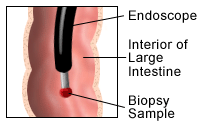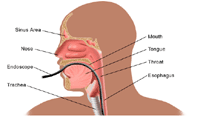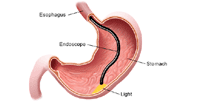What are the different types of endoscopic examinations?
An endoscope is a small, flexible tube with a light and a lens on the end used to look into the esophagus, stomach, duodenum, colon or rectum. It also can be used to take tissue from the body for testing or to take color photographs of the inside of the body. Cystoscopes, colonoscopes and sigmoidoscopes are types of endoscopes and are described below:
- Colonoscopy – a procedure that allows the physician to view the entire length of the large intestine, and can often help identify abnormal growths, inflamed tissue, ulcers and bleeding. It involves inserting a colonoscope, a long, flexible, lighted tube, in through the rectum up into the colon. The colonoscope allows the physician to see the lining of the colon, remove tissue for further examination and possibly treat some problems that are discovered.
- Endoscopic retrograde cholangiopancreatography – a procedure that allows the physician to diagnose and treat problems in the liver, gallbladder, bile ducts and pancreas. The procedure combines X-ray and the use of an endoscope — a long, flexible, lighted tube. The scope is guided through the person’s mouth and throat, then through the esophagus, stomach and duodenum. The physician can examine the inside of these organs and detect any abnormalities. A tube is then passed through the scope and a dye is injected, which will allow the internal organs to appear on an X-ray.
- Esophagogastroduodenoscopy (also called EGD or upper endoscopy) – a procedure that allows the physician to examine the inside of the esophagus, stomach and duodenum. A thin, flexible, lighted tube, called an endoscope, is guided into the mouth and throat, then into the esophagus, stomach and duodenum. The endoscope allows the physician to view the inside of this area of the body, as well as to insert instruments through a scope for the removal of a sample of tissue for biopsy (if necessary).
- Sigmoidoscopy – a diagnostic procedure that allows the physician to examine the inside of a portion of the large intestine, and is helpful in identifying the causes of diarrhea, abdominal pain, constipation, abnormal growths and bleeding. A short, flexible, lighted tube, called a sigmoidoscope, is inserted into the intestine through the rectum. The scope blows air into the intestine to inflate it and make viewing the inside easier.
- Cystoscopy (also called cystourethroscopy) – an examination in which a scope, a flexible tube and viewing device, is inserted through the urethra to examine the bladder and urinary tract for structural abnormalities or obstructions, such as tumors or stones. Samples of the bladder tissue may be removed through the cystoscope for examination under a microscope in the laboratory.





